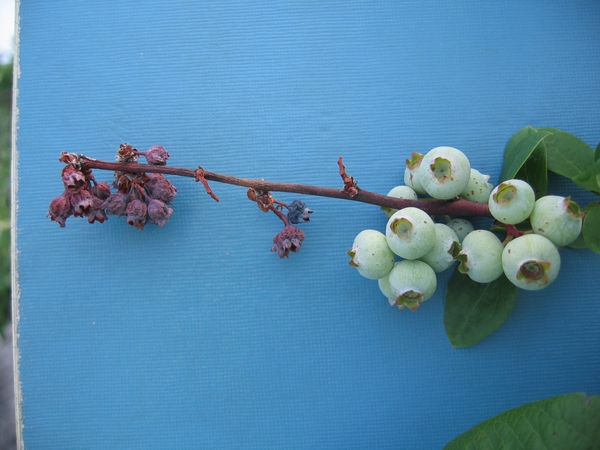General Information
Twig blight is a fungal disease that causes causes a dieback of fruit-bearing twigs on highbush and rabbiteye blueberry bushes. Yield losses as high as 70% have been recorded on susceptible varieties when fungicidal sprays are not used.
Symptoms
Visible symptoms first occur in late February to early March in southeastern North Carolina, soon after the flower buds reach the green-tip stage. Individual buds turn brown and die, followed by browning and necrosis of bark around the bud as the fungus spreads from the blighted bud into the twig. The disease usually spreads down the twig until most or all of the flower buds on an individual twig are killed.
Twig blight can continue to infect fruit-bearing twigs at all stages of development. New infections occur continually as buds open, flower, and produce fruit. The disease stops progressing after killing the twig (6-10 inches), and does not progress further down the stem to infect older wood. The slender leaf-bearing buds which develop lower on the twig are not initial points of infection with this disease, but they may be killed as the infection spreads down from the flower buds.
Disease Cycle
The fungus (Phomopsis vaccinii) overwinters in dead twigs infected during the previous year. Beginning in February, spores (conidia) are released from the old infections and dispersed by wind and rain. The largest numbers of conidia are released from budbreak in February through bloom in April; conidia become trapped in opening buds, germinate, and infect the vascular system. After the twig is killed, fruiting bodies called pycnidia are produced just under the surface of the bark. these fruiting bodies exude conidia which can cause additional infections, with conidial production continuing into August.
Control
1. Pruning can be performed to remove infected twigs prior to spore release in the spring. This will decrease the amount of disease inoculum present at budbreak. While this technique may not be practical for large commercial operations, growers with less acreage and home gardeners should benefit from this sanitation method. Commercial growers who mow bushes in June and July after harvest (topping) will also benefit from the removal of blighted twigs that would otherwise overwinter and provide spores to infect new twigs.
2. Careful cultivar selection can greatly reduce the amount of twig blight experienced. Newer cultivars (Legacy, New Hanover, O'Neal, Star, Farthing) are generally resistant to twig blight. Older highbush cultivars Murphy and Harrison were highly susceptible and for this reason are no longer widely grown. Some rabbiteye cultivars are susceptible, notably Delite.
3. Chemical control can be acheived by spraying labeled fungicides from budbreak through bloom on a 7-14 day interval. For the most current information on chemical control, see the North Carolina Agricultural Chemicals Manual.
Fruit Rot Stage
Phomopsis vaccinii also causes a fruit rot on blueberry at harvest in North Carolina. Infected berries become very soft and may split resulting in leakage of juice. The cultivar Harrison is extremely susceptible and for this reason is no longer recommended for planting in North Carolina. Most other varieties can be grown with minimal loss due to the fruit rot stage if fruit is harvested in a timely fashion to avoid overripe fruit on the bush. In North Carolina, fruiting bushes should be harvested every 7 days or less.
Cane Canker Stage
In southern Michigan and northern Indiana, this fungus causes a cane canker which kills entire stems. Symptoms are similar to those of blueberry stem blight, a common disease in the southeastern United States. This disease stage of Phomopsis vaccinii has not been observed to occur in North Carolina.
Other Resources
Fruit Disease Notes
IPM Fruit Information for North Carolina
HIL-201 Suggestions for Establishing a Blueberry Planting in Western North Carolina
HIL-201B Principles of Pruning the Highbush Blueberry
HIL-201E Blueberry Freeze Damage and Protection Measures
North Carolina Entomology Insect Notes
North Carolina Agricultural Chemicals Manual
For assistance with a specific problem, contact your local N.C. Cooperative Extension center.
Note on Recommendations
Recommendations of specific chemicals are based upon information on the manufacturer's label and performance in a limited number of trials. Because environmental conditions and methods of application by growers may vary widely, performance of the chemical will not always conform to the safety and pest control standards indicated by experimental data.
Publication date: Jan. 2, 2014
Reviewed/Revised: Jan. 3, 2024
Recommendations for the use of agricultural chemicals are included in this publication as a convenience to the reader. The use of brand names and any mention or listing of commercial products or services in this publication does not imply endorsement by NC State University or N.C. A&T State University nor discrimination against similar products or services not mentioned. Individuals who use agricultural chemicals are responsible for ensuring that the intended use complies with current regulations and conforms to the product label. Be sure to obtain current information about usage regulations and examine a current product label before applying any chemical. For assistance, contact your local N.C. Cooperative Extension county center.
N.C. Cooperative Extension prohibits discrimination and harassment regardless of age, color, disability, family and marital status, gender identity, national origin, political beliefs, race, religion, sex (including pregnancy), sexual orientation and veteran status.




